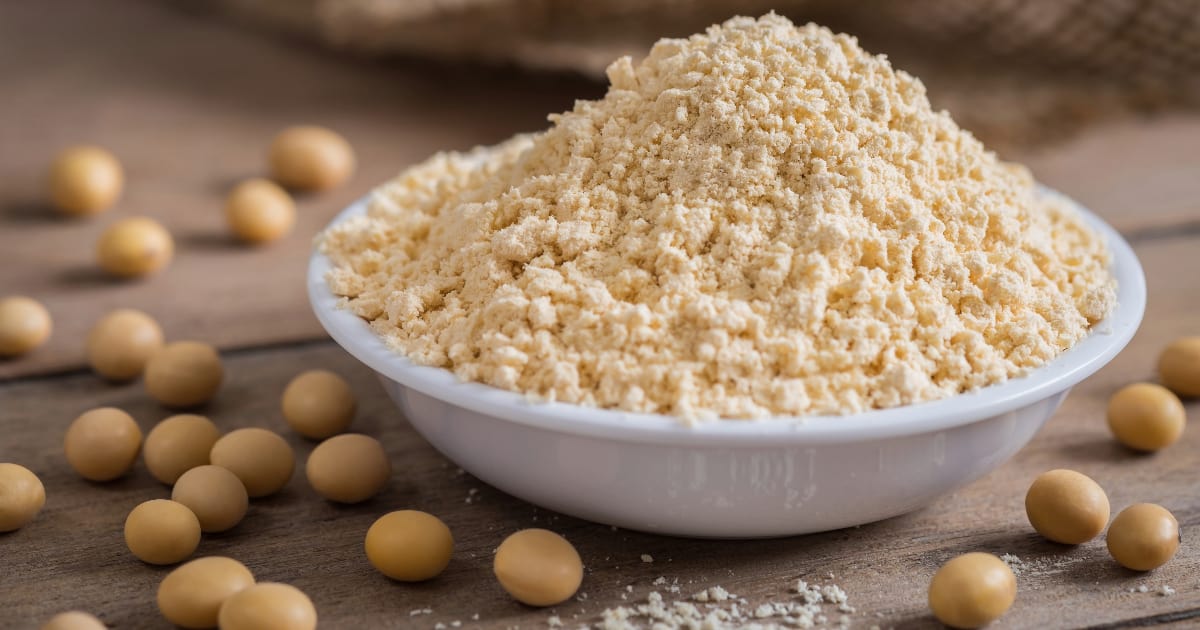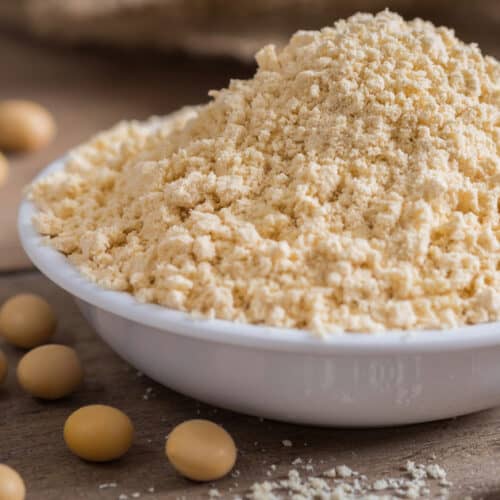Soybean powder, also known as kinako, is a versatile ingredient made from roasted soybeans ground into a fine powder.

It has a sweet, nutty flavor reminiscent of peanuts or hazelnuts that can enhance both sweet and savory dishes.
There are several benefits to making your own soybean powder rather than buying it pre-made:
- Cost savings: Store-bought kinako can be expensive, so making it at home is cheaper.
- Customize roast level: You can control how light or dark you toast the beans to suit your taste preferences. Darker roasts have a more intense, bittersweet flavor.
- Ingredient control: By making it yourself, you know exactly what goes into your kinako. No questionable additives.
- Fresher product: Homemade powder will taste fresher than a package that's been sitting on the shelf.
- Fun DIY project: It can be gratifying to make ingredients from scratch.
Soybean Powder Ingredients
The only ingredient you need to make roasted soybean powder is:
- Soybeans (dried)
When selecting soybeans, choose a variety that is meant for cooking/eating, rather than crops grown for oil production or animal feed. Good options include black or yellow soybeans.
Equipment Needed
You'll need the following basic kitchen tools:
- Baking sheet
- Large skillet
- Spice grinder, blender, food processor, or coffee grinder
- Fine mesh strainer or sieve
The most important tool is a high-powered blender or food processor that can grind the toasted beans into a super fine powder. A basic model may struggle to get the consistency right.
Step-by-Step Instructions

Soybean Powder Recipe
Ingredients
- Soybeans (dried)
Instructions
Rinse and Dry Soybeans
- Rinse the dried soybeans under running water to remove any dirt or debris. Spread them out on a clean kitchen towel and pat dry thoroughly. Removing excess moisture prevents splattering when roasting.
Roast Soybeans
- Pour the dried beans in a single layer onto a rimmed baking sheet. Roast at 400°F for 15-20 minutes, gently stirring halfway through. The soybeans are ready when lightly browned and fragrant. Be careful not to burn them.
- Alternatively, you can roast in a dry skillet on the stovetop over medium-low heat for 10-15 minutes instead, stirring frequently.
Cool Completely
- The toasted soybeans need to cool down fully before grinding to prevent the released oils from becoming gummy. Spread out on a baking sheet or plate to cool quickly.
Grind Into Powder
- Working in small batches, grind the roasted beans into a fine powder using a blender, food processor, spice grinder, or coffee grinder. Avoid overloading it.
- For electric models, pulse in short bursts to prevent overheating. Process each batch for 2-3 minutes until very finely ground.
Sift Powder
- Sift the soybean powder through a fine mesh strainer or sieve to remove any large gritty bits. Discard any remnants that won't pass through. The final product should have a super fine, smooth consistency.
Store Properly
- Transfer the fresh soybean powder into an airtight container. Store in a cool, dark place like the pantry for up to 3 months. For maximum shelf life, store in the refrigerator.
- And that's it! With just 5 simple steps, you can now make delicious roasted soybean powder from the comfort of your own kitchen. Adjust the roast time to customize the intensity of the nutty flavor to your preferences.
How to Use Soybean Powder
This versatile Japanese pantry staple brings loads of nutty flavor and nutrition to both sweet and savory recipes. Here are some tasty ways to use your homemade soybean powder:
Dessert Topping
Kinako makes an excellent topping for cakes, cookies, ice cream sundaes, crepes, waffles, etc. For extra sweetness, mix it with sugar before sprinkling. The roasted aroma pairs especially well with chocolate or fruits.
Rice Cake Coating
Coat mochi and dango rice cakes with soybean powder to add flavor without making them sticky. The traditional combo of kinako and brown sugar gives texture and crunch too.
Smoothies and Lattes
Stir spoonfuls of the powder into smoothie bowls, protein shakes, oatmeal, yogurt, etc. Soybean powder also makes a tasty, creamer-free addition to lattes and hot chocolate.
Savory Dishes
Mix kinako into tempura or fried fish batters right before frying for extra crunch. It's also excellent sprinkled onto soups, noodles bowls, fried rice, avocado toast, popcorn, etc.
Get creative with homemade soybean powder! Its mildly sweet nuttiness complements both sweet and savory ingredients.
Table 1: Sweet and Savory Uses for Soybean Powder
| Sweet Uses | Savory Uses |
|---|---|
| Cake, cookie, donut coating | Tempura batter |
| Ice cream topping | Soups and broths |
| Crepe filling | Fried rice |
| Lattes and hot chocolate | Avocado toast topping |
| Smoothie booster | Salad sprinkles |
Soybean Powder Nutrition
In addition to its delicious toasted flavor, soybean powder packs some nutritional perks as well. Here are some of the top nutrients found in kinako:
- Protein: Soybeans are a complete vegetarian protein containing all 9 essential amino acids. Just 2 tablespoons provide over 5 grams.
- Fiber: Kinako offers 2 grams of fiber per serving to support healthy digestion and heart health.
- Iron: Essential for oxygen transport in the blood. Soybeans have a whopping 49% of your daily iron needs.
- Calcium: The calcium in soybeans build strong bones and aids muscle and nerve functioning.
Soy also contains antioxidants called isoflavones that may help prevent heart disease and certain cancers.
Troubleshooting Homemade Soybean Powder
Making soybean powder is simple, but here are some tips if you run into any problems:
Beans burn while roasting
- Use lower heat, stir more frequently, and spread into a single layer so they cook evenly. Watch them closely.
Powder has some coarse grit
- Check that your grinder blade is sharp. Process in smaller batches and for a longer duration until super fine.
Flavor is too bitter
- You may have roasted the beans too long. Try reducing the cook time for a sweeter nutty taste.
Powder doesn't keep long
- Store kinako in an airtight container in the fridge or freezer to maximize freshness. Use within 3 months.
Making adjustments to the roasting time and grinding method can help troubleshoot any texture/flavor issues with homemade soybean powder.
FAQs
Can I use a blender instead of a food processor to grind?
Yes, you can use either a standalone blender or spice grinder to pulverize the toasted soybeans into powder. Just work in small batches and blend until very finely ground. Expect it to take a few minutes per batch.
Do I need to boil the soybeans before roasting?
No. Simply washing and patting dry is sufficient prep before roasting soybeans to make kinako. Unlike making soy milk or tofu, boiling is not required.
What are some substitutes for soybean powder?
Peanut flour has a similar nutty flavor, while almond flour also works well in lighter baked goods. For savory uses, ground roasted sesame seeds or even panko breadcrumbs can provide crunch.
Can I make soybean powder from scratch with raw beans?
Technically yes, but roasting the beans beforehand drastically improves both the flavor and digestibility. Raw soybean powder would taste grassy and unpleasant. Always start with dried roasted soybeans for best results.
Conclusion
Homemade roasted soybean powder takes just minutes to whip up and offers amazing nutty flavor and versatility.
Adjust the roast level to your preferred intensity, then use kinako to create both sweet and savory treats.

